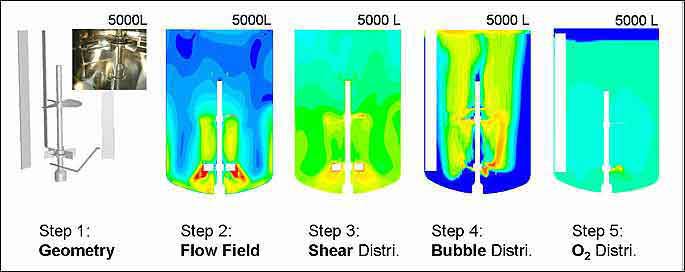Typical Steps of CFD Simulation Process
Posted by: Mehul Patel | Posted on: June 11th, 2013
Computational Fluid Dynamics (CFD) is a branch of fluid mechanics that uses numerical methods and algorithms to solve and analyze problem that involves fluid flow. CFD modeling is based on fundamental governing equations of fluid dynamics: the conservation of mass, momentum, and energy.CFD helps to predict the fluid flow behavior based on the mathematical modeling using software tools.It is now widely used and is acceptable as a valid engineering tool in the industry.

The CFD simulation process consists of several steps that are involved in the analysis of the fluid flow. For example; if we are talking about flow through a pipe bend. Then there are several steps that need to be followed for its analysis.
CFD process Consists of Three Primary Steps:
Pr-Processing: This is the first step of CFD simulation process which helps in describing the geometry in the best possible manner. One needs to identify the fluid domain of interest. The domain of interest is then further divided into smaller segments known as mesh generation step. There are different popular Pre-Processing software available in the market including: Gridgen, CFD-GEOM, ANSYS Meshing, ANSYS ICEM CFD, TGrid etc.
Solver: Once the problem physics has been identified, fluid material properties, flow physics model, and boundary conditions are set to solve using a computer. There are popular commercial software available for this including: ANSYS FLUENT, ANSYS CFX, Star CCM, CFD++, OpenFOAM etc. All these software have their unique capabilities. Using this software; it is possible to solve the governing equations related to flow physics problem.
Post-Processing: The next step after getting the results is to analyze the results with different methods like contour plots, vector plot, streamlines, data curve etc. for appropriate graphical representations and report. Some of the popular post-processing software include: ANSYS CFD-Post, EnSight, FieldView, ParaView, Tecplot 360 etc.
May be you like to read more about : 4 Practical Advantages of Employing Computational Fluid Dynamics
(Image Source: morbidelli-group.ethz.ch)

About Author: Mehul Patel specializes in handling CFD projects for Automobile, Aerospace, Oil and Gas and building HVAC sectors. He works as a CFD consultant with Hi-Tech CFD for the past 5 years and has successfully executed numerous CFD projects of high complexities. He is an expert in turbo-machinery, gas dynamics, Combustion, Fluid Dynamics, multiphase flow analysis, computational fluid dynamics etc.
